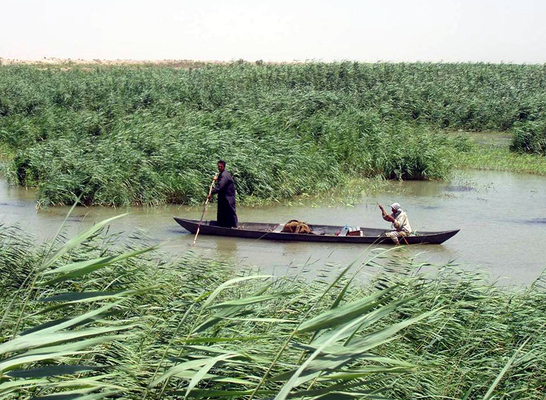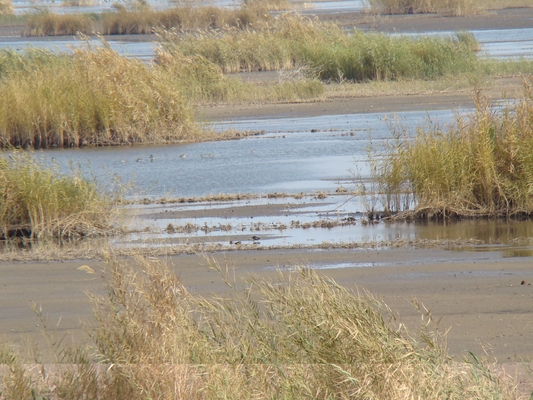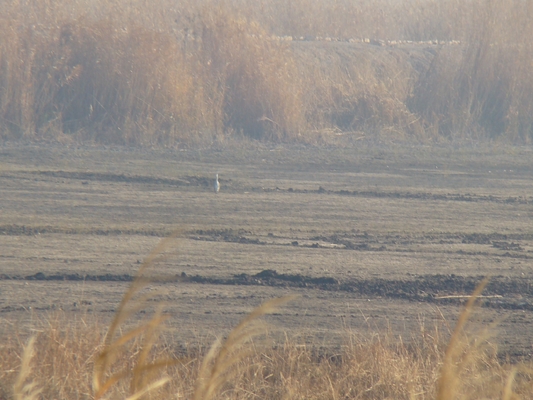
by Erin Wayman Thursday, January 5, 2012

Iraq's marshes in 2003. Today, the marshes are drying up due to a drought and competition over limited water supplies. Hassan Janali, U.S. Army Corps of Engineers

A two-year drought and competition over limited water supplies threaten Iraq's marshes, including this one pictured here in December 2008. University of Basrah, courtesy of Dr. Hussain

A two-year drought and competition over limited water supplies threatens Iraq's marshes, including this one pictured here in 2008. Note the dike in the background. University of Basrah, courtesy of Dr. Hussain
Since the downfall of Saddam Hussein in 2003, Iraqis and scientists from around the world have been working hard to restore Iraq’s once-lush marshes. But after several years of measurable improvement, drought and competition over limited water supplies threaten to reverse this progress. Those working on the marshes are confident that the marshes can come back — but whether the people who rely on these wetlands for their livelihood will be as resilient remains to be seen.
Many scholars cite Iraq’s fertile marshes as the inspiration for the biblical Garden of Eden. And for thousands of years, the marshes nestled in the Fertile Crescent between the Tigris and Euphrates rivers in southern Iraq sustained the region’s inhabitants, the Marsh Arabs, who relied on the wetlands to fish, feed their livestock, and harvest reeds to build their homes. But in the 1950s and 1960s, Iraq started to build dams on the rivers that feed the marshes to store water in reservoirs. Under Hussein’s rule, even more dams, dikes and canals were built on these rivers in an effort to purposefully dry the marshes to quell any insurgents hiding in the marshes along the Iraq-Iran border. Then in the late 1990s, a severe drought set in. By 2000, less than 10 percent of Iraq’s more than 15,000 square kilometers of marshes remained; the rest was nothing more than barren patches of parched soil.
But as soon as Hussein’s regime was toppled, the Marsh Arabs still living near the marshes started tearing down the dams and embankments, re-flooding the marshland. Scientists from around the world came to help jumpstart the marshes' rebirth.
“Things have been going pretty well,” says Andrea Cattarossi, a hydrologist who subcontracts with Nature Iraq, a non-governmental organization that is helping to restore the marshes. “It doesn’t take long for nature to regain control,” he says. In November 2003, for example, when Cattarossi toured the marshes, he only saw bare soil. But by January of the next year, reeds were already as tall as he was. A 2006 study suggested that 75 percent of the marshes that existed in 1973 could be restored. That year, the marshes showed that this goal was within reach, Cattarossi says: 65 percent of the marshes had already returned, populated with the grasses, fish and birds that had been absent for years.
But in the last couple of years, the marshes have shrunk again, Cattarossi says. They are now closer to 40 percent of the 1973 levels.
One of the main problems is a drought that began last year. Last month, water levels in the marshes were still low. That doesn’t bode well for the summer dry season because the marshes receive most of their water in March and April, when the snowpack in Turkey’s highlands melts and replenishes the Tigris and Euphrates, says Hassan Partow, an environmental affairs officer for the U.N. Environment Programme in Geneva, Switzerland.
Cycles of drought are common in this part of the world, and the marshes have evolved to handle the ebbs and flows, Partow says. But the marshes weren’t designed to cope with the structures built upstream that restrict and divert the flow of the Tigris, Euphrates and other rivers. And even as the dams in Iraq come down, more dams and dikes are still being built. Turkey’s Southeastern Anatolia Irrigation Project, for example, is a series of 22 dams that diverts much of the Euphrates to irrigate 1.7 million hectares of agricultural fields. When the project is completed, it will leave Iraq with less than 50 percent of the water it historically got, says Azzam Alwash, director of Nature Iraq.
Because of the current drought, Turkey, Syria and Iran, as well as Iraq, are also diverting more water for storage in their dwindling reservoirs, leaving less for the marshes, Cattarossi says. In March, Turkey’s president, Abdullah Gul, pledged to double the amount of water going to Iraq. But when this will happen is unclear, Cattarossi says.
Once water reaches Iraq, the marshes then have to compete with thirsty citizens and irrigated agriculture for access. By some estimates, Iraq’s water demand is 90 billion cubic meters of water per year. The marshes, if restored to 75 percent of 1973 levels, need about half of that, says Curtis Richardson, a wetlands ecologist at Duke University in Durham, N.C. But “when it comes to food or marshes,” Richardson says, “it’s a no brainer.” Food will win out.
With all the competing water demands, there just isn’t enough water to restore the marshes to the high levels people are talking about, he says. Only about 35 to 40 percent of the 1973-level marshes can be sustained in the long term, he says. But even that, he notes, would still be “phenomenal.”
For now, Iraq is doing what it can to restore its marshes. The Iraqi Ministry of Water Resources is installing a series of 17 instruments that will store and release water to mimic historical flow. That project should be finished within the next two years, Alwash says. They are also installing about 130 stream gauges to collect real-time flow data.
“I have no doubt that the marshes will survive,” Alwash says. He is more concerned about the people who depend on the marshes. Cattarossi shares that concern. “Nature adjusts more easily [than people do],” he says. “A lot of the families left the marshes in 2000 to 2002, and then returned. And now they’re leaving again. They may not come back.”
© 2008-2021. All rights reserved. Any copying, redistribution or retransmission of any of the contents of this service without the expressed written permission of the American Geosciences Institute is expressly prohibited. Click here for all copyright requests.